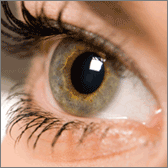
Photorefractive Keratectomy, or PRK, is a surgical procedure utilizing an excimer laser to reshape the central cornea to a flatter shape for people who are nearsighted and a more curved surface for people who are farsighted. PRK techniques can also be used to correct astigmatism.
An excimer laser is used to reshape the curve of the cornea. A computer is used to compute the depth and pattern of the tissue to be removed. It then delivers gentle pulses of concentrated, cool ultraviolet light beams, precisely focused, to correct the shape of the curve.
After the laser treatment, the cornea is covered with a bandage contact lens. Within days, new epithelial cells grow back and the bandage contact is removed.
The basic steps in PRK surgery are:
- Anesthetic eye drops are applied to the eye to prevent discomfort during surgery.
- A central area of corneal epithelium is removed - either with a laser or manually after being softened with a dilute alcohol solution.
- An excimer laser is used to reshape the underlying corneal tissue.
- Antibiotic and anti-inflammatory drops are applied to the eye, and the eye is covered with a bandage contact lens.
Two or three days later (after the epithelium has had a chance to grow back), the bandage contact lens is removed.
An updated version of PRK is now being performed; it is referred to as Advanced Surface Ablation (ASA).
Recovery time: 3 - 5 days. Between one and three days after your PRK, you can expect some discomfort, potentially including irritated, burning eyes; light sensitivity; tearing; and swollen eyelids. Most of this discomfort can be attributed to the removal of the epithelium, which acts as a natural barrier between your eye and your environment. However, some patients experience little or even no discomfort during this time.